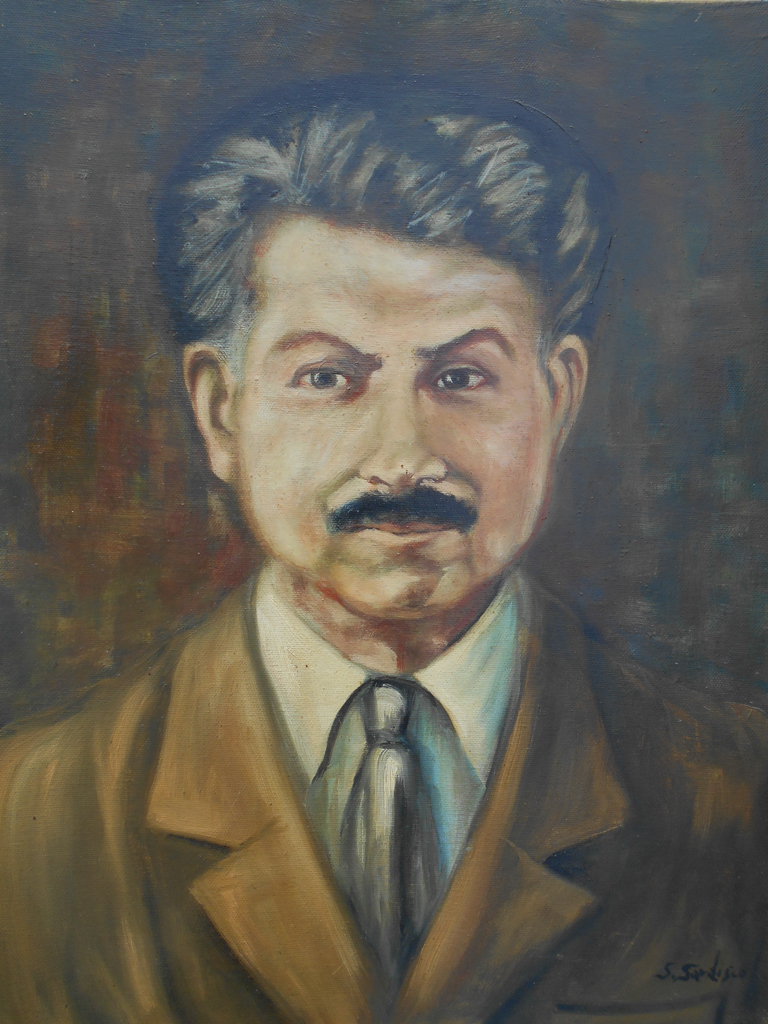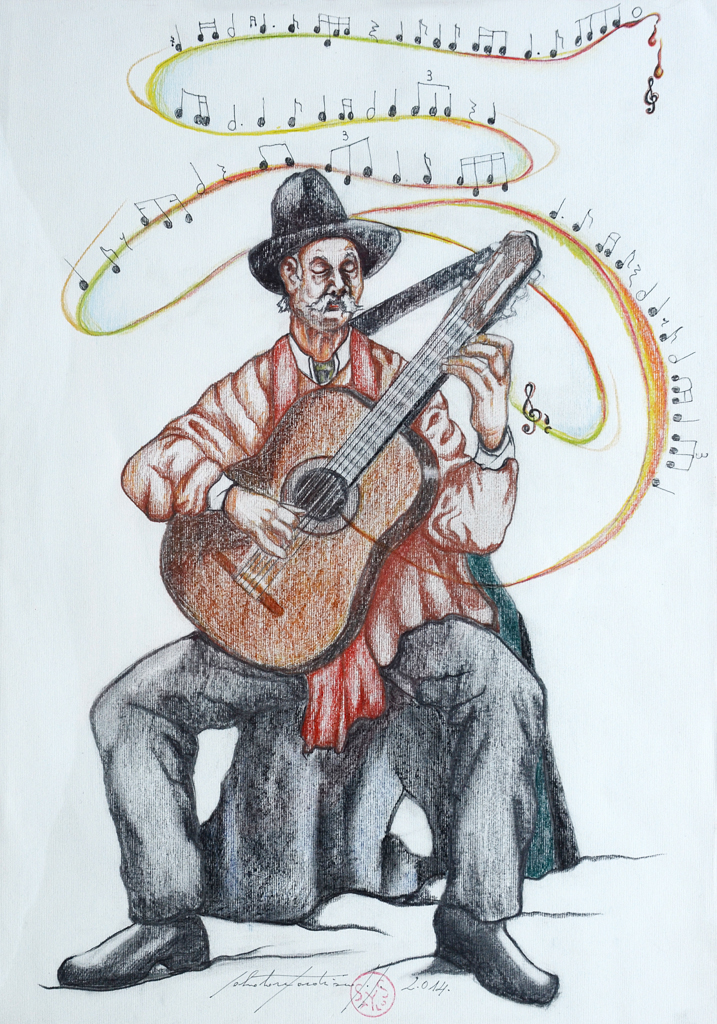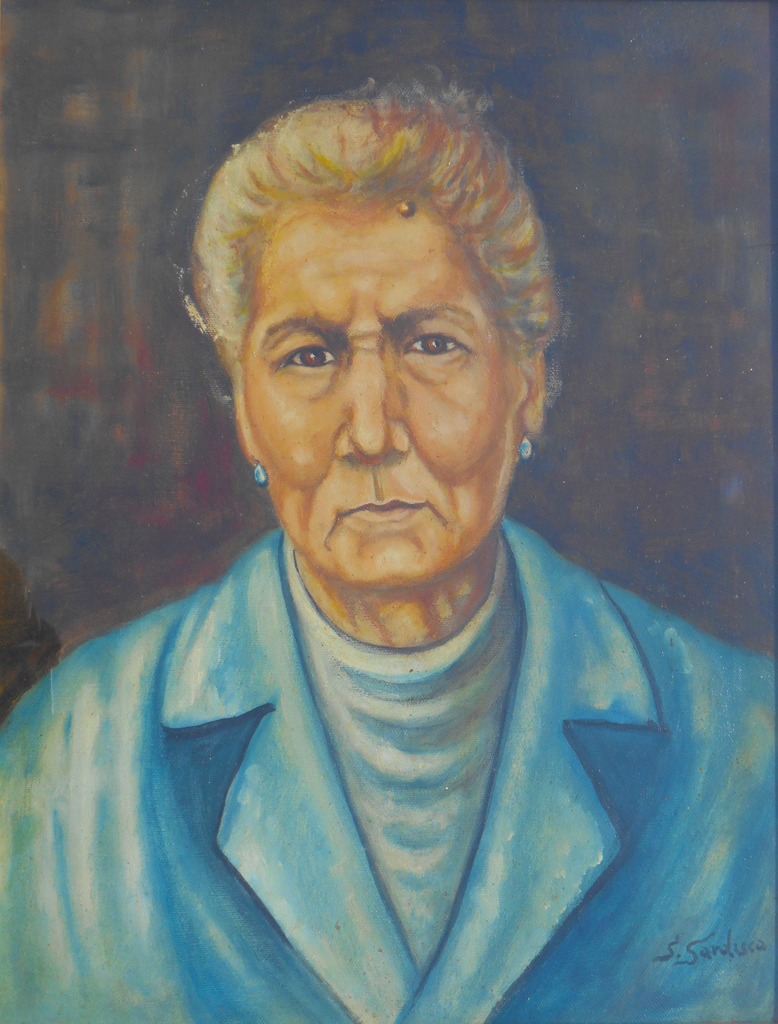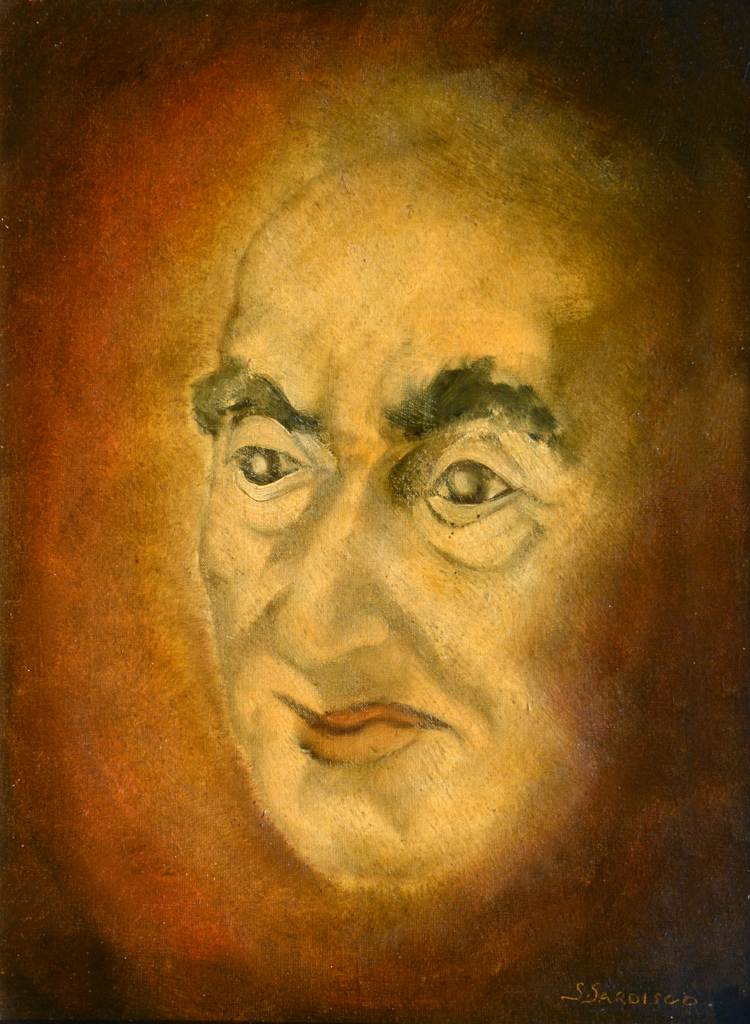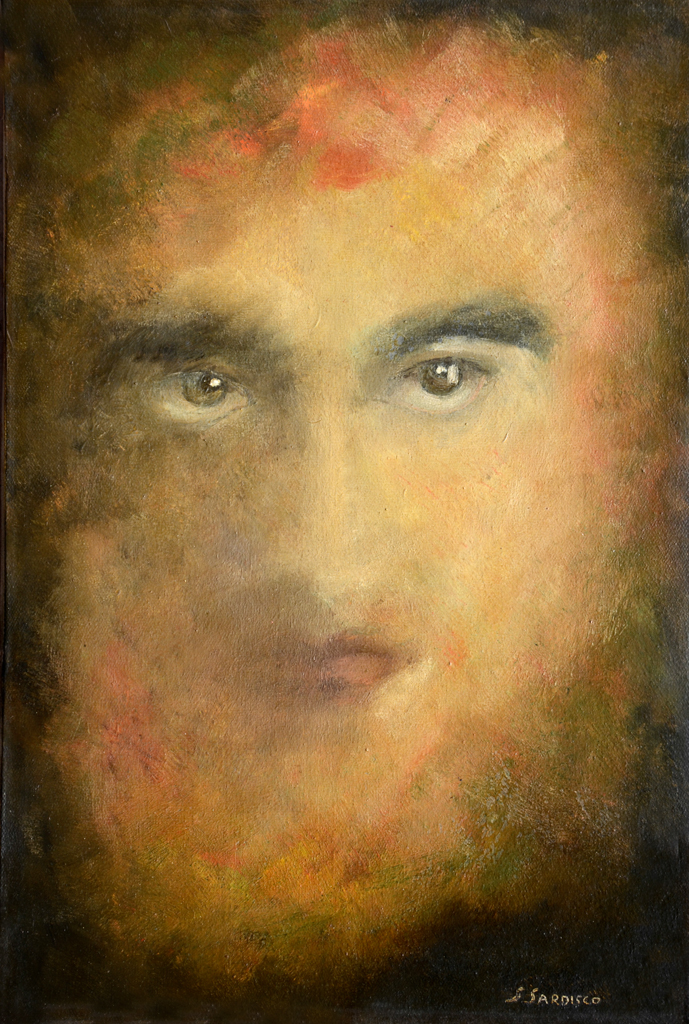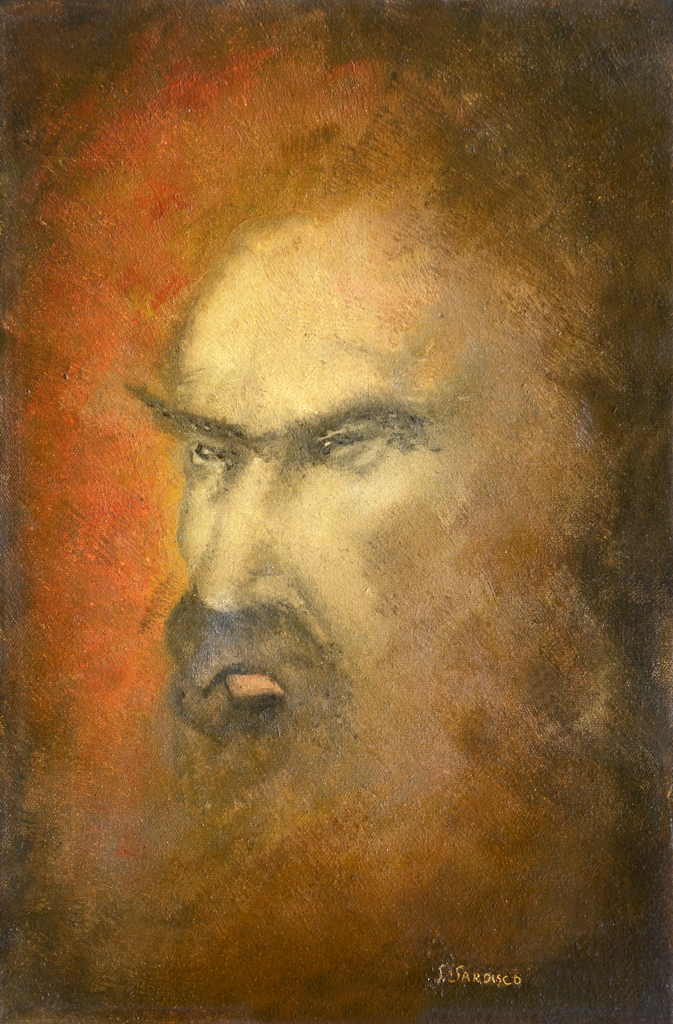26
Nonno
1973, 50 x 40, olio su tela
Qui risalta la diversa personalità del nonno, che è come se tornasse a vivere con la sua prorompente vitalità, l’arguzia e il desiderio di sorridere alle difficoltà di un’esistenza umile, ma non per questo occasione di autentica felicità. È come una bellissima ed intensa foto a colori di un nostro avo vestito a festa, fiero e orgoglioso di esserci. Il ritratto, infatti, nasce senza che Salvatore lo abbia conosciuto in vita.
Here the different personality of Sardisco’s grandfather, who returnes to live with his great vitality, with the keenness and with the desire to smile at the difficulties of a humble existence, but not for this occasion of authentic happiness. It’s as a very beautiful and intense photograph of one ancestor of ours dressed to party, who is proud to be there. Sardisco has painted without having known him from alive.
26
Il Chitarrista
2014, 30 x 42, carboncino e sanguigno
Ancora un personaggio, il chitarrista, immortalato nel suo raccolto virtuosismo musicale, con gli occhi socchiusi e come trasportato dalle note che lo strumento “innalza” al cielo, come un inno alla gioia di vivere. I tratti semplici e sapienti della figura creano una profondità espressiva che ne fanno un piccolo capolavoro artistico.
The guitarist, still a character immortalized in his intimate musical virtuosity, with half open eyes, transported by the notes that the string instrument “raises” to the sky. A hymn to the joy of life. The simple and wise lines of the figure create an expressive depth for a small artistic masterpiece.
02
Nonna
1973, 50 x 40, olio su tela
Il volto della nonna, “angelicata” nel suo vestito turchino, esprime la sua vita, le sofferenze e la fierezza di averle superate. È un’opera nella quale i pensieri, gli affetti e i sentimenti sono sublimati nei tratti realistici di chi, come lei, ha conosciuto il difficile “mestiere di vivere” e si è spesa per la famiglia. A lei l’artista si rivolge con rispetto e amore silenziosi.
The Sardisco’s grandmother face in deep blue suit expresses her life: the pride over sufferings. It’s a work in which the thoughts, the affections and the feelings are sublimed in the realistic lines of who, as she, has known the difficulty “work to live” and she is spent for the family. The artist turns to her with respect and silent love.
16
Il Compiacimento
1972, 30 x 40 olio su tela
Gli occhi e la bocca restituiscono l’intima soddisfazione di chi si riconosce in un’opera o in un’azione compiuta, al punto di rimanerne come orgoglioso.
The eyes and the mouth gives the intimate satisfaction of who is recognizing in an opera or in a finished action, so that remaining proud of it.
12
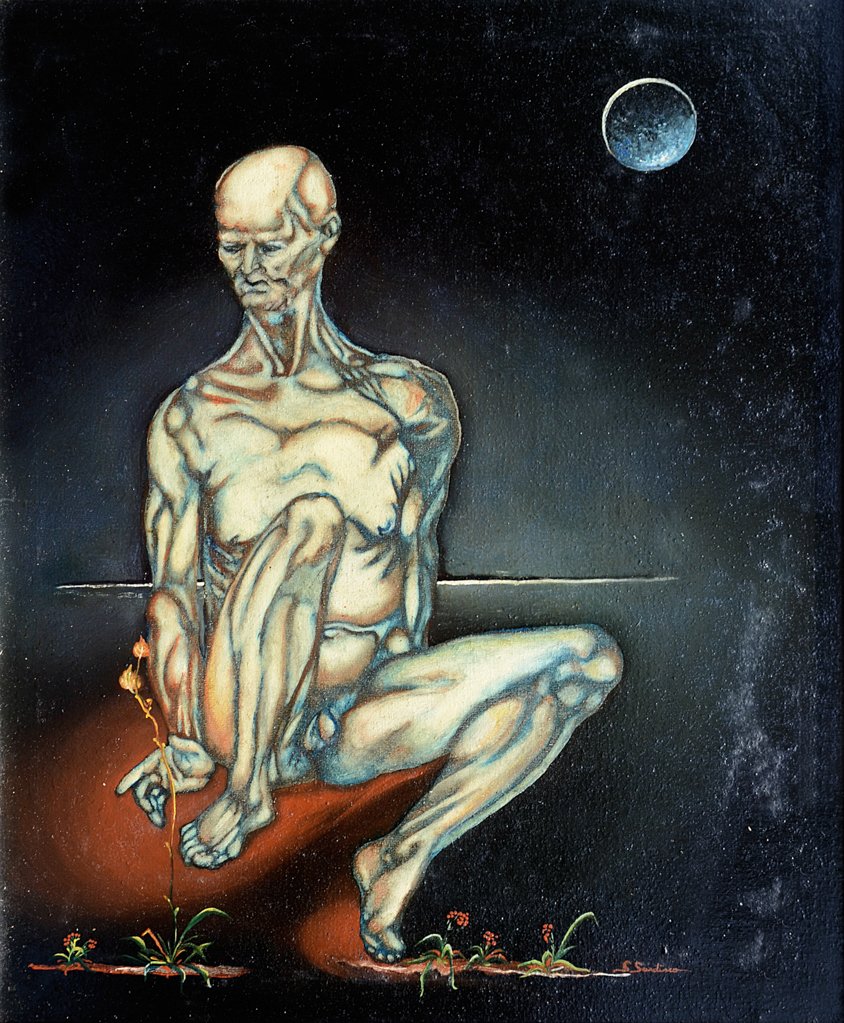
Crepuscolo della vita
1978, 50 x 60 olio su tela
L’immagine è potente e michelangiolesca nella sua plasticità.
L’uomo di età matura è raffigurato nudo con uno sguardo pensieroso e meditabondo sul senso della vita e della propria esistenza.
In realtà la forza espressiva dell’opera è tale che l’atteggiamento indica, universalizzandolo, il sentimento proprio dell’umanità intera al termine dell’esistenza, quel ripiegare su noi stessi e chiederci se abbiamo vissuto dignitosamente sui sentieri del Bene oppure no.
Dubbi amletici che sembrano rimandare al senso della vita, dell’universo, dello spazio.
Da qui la decisa impronta metafisica che l’uomo acquista, raffigurato nei tratti anatomici essenziali, con un pianeta celeste che pare osservare ed accompagnare impassibile le vicende umane, come l’occhio della verità ultima.
Piccoli cespugli di fiori semplici raffigurano l’essenza profonda di ciò che ci circonda e ci fa gioire intimamente: la bellezza delle cose, e metafisicamente anche delle opere semplici che, sole, ci riscattano dall’inadeguatezza difronte alla Verità e al Divino e che l’uomo pare accarezzare.
All’orizzonte in lontananza “una linea” che, nell’immensità dell’Universo e nella profondità dell’infinito, crea e diffonde un chiarore di luce mentre un tramonto accompagna con i suoi colori un sentimento nuovo di speranza.
Verità o lusinga e inganno?
The image in powerful in its plasticity. The man of mature age is represented naked with thoughful look on the sense of the life and his own existence. The expressive strenght is such an attitude points out, universalizing it, the feeling proper of the whole humanity at the end of the existence that to refold on ourselves and to ask us if we have dignifiedly lived on the paths of the Good, or not. Doubtful that seems to postpone the sense of life, of universe and of space. The man increases a metaphysic marks represented in the essential anatomical lines with a celestial planet that impassive seems to observe and to accompany the human stories. like an eye of a definitive truth. Doubts that seems to refer the sense of life, of universe, of space.
Small bushes of simple flowers represent the deep essence which surrounds, which bring joy intimately: the beauty of the things and of the simple opera that redeem us from the inadequacy in front of the Truth and the Divine One.
A line is at the horizonhat, in the immensity of the universe and in the depth of the infinity; it’s creates and it spreads a light while a sunset brings a new feeling of hope.
Truth or promise and illusion?
04
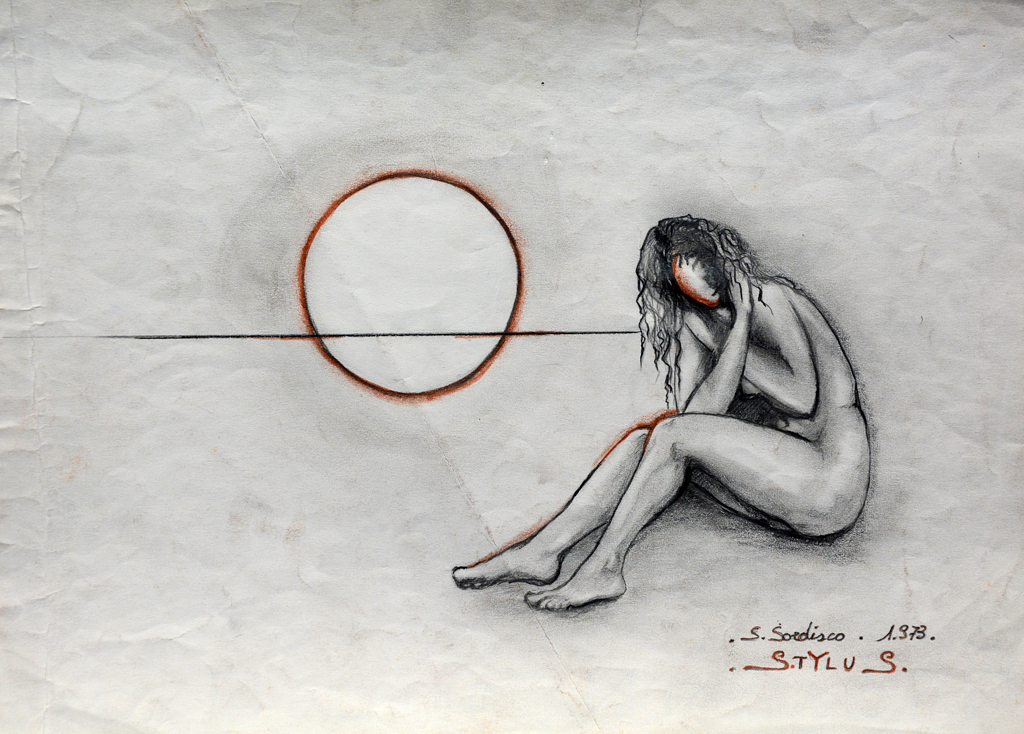 L’Incompiuta
L’Incompiuta
1973, 31.5 x 24 carboncino su carta
Ritratto di un’amica dell’artista, priva di volto, in modo da rimanere donna senza tempo. In questo rappresenta il femmineo dell’artista ancora giovanissimo: la donna pudica che si ripiega su se stessa a nascondere la sua nudità. L’aggiunta del sole/luna è stata successiva.
Da notare la semplicità e classicità dei dettagli anatomici dovuti agli studi dell’artista.
Portrait of a friend of the artist, deprived of face like a woman without time. The feminine one is represented by the young artist: the chaste woman folded down on herself, hiding her nudity. The addition of the sun/moon is later.
To this and is shoud be noted the simplicity and the classical nature of the anatomical details, by Sardisco’s studies of anatomy.
04
Autoritratto
1973, 30 x 45 olio su tela
L’opera è stata realizzata cercando in uno specchio il proprio volto. È negli occhi che si può vedere la verità e l’anima per riscoprire l’identità persa: chi sono? Cosa vado cercando? È negli occhi che l’artista ritrova se stesso, assapora la vita in tutte le sue forme e manifestazioni, esce dalla solitudine dell’anima, riesce a conoscersi.
Autoritratto è un’opera enigmatica che meglio ci aiuta a comprendere l’umanità di Sardisco: il suo affacciarsi al significato di tutto ciò che lo circonda, sguardo senza tempo alla ricerca di un perchè.
This painting has been realized looking for his own face in a mirror. In the eyes you can see the truth and the soul for rediscovering the lost identity: who am I? What I’m looling for? In the eyes the artist finds again himself, he tastes the life in all forms and demonstrations. He goes out of the loneliness of the soul, he’s able to identify himself.
This is an enigmantic painting that helps us to understand the humanity of Sardisco: his ability to preapare the meaning of all that surrounds him; his looking without time in the research of a reason.
04
Il Peso del passato
1972, 30 x 40 olio su tela
L’uomo è come “sommerso” nei pensieri e dal fardello della propria vita, in un ripensare che è come fare i conti con la propria esistenza, cercando di scrutarvi un senso, un significato, la ragione ultima di una tensione “amletica” che stavolta, insieme allo sguardo, sono le labbra a indicarci.
The man is surrounded by his thoughts and by a weary life, reflecting and reconsidering his own existence, perceiveing a sense and a meaning; searching for the last reason of an amletic tension showing by lips and look together.
04
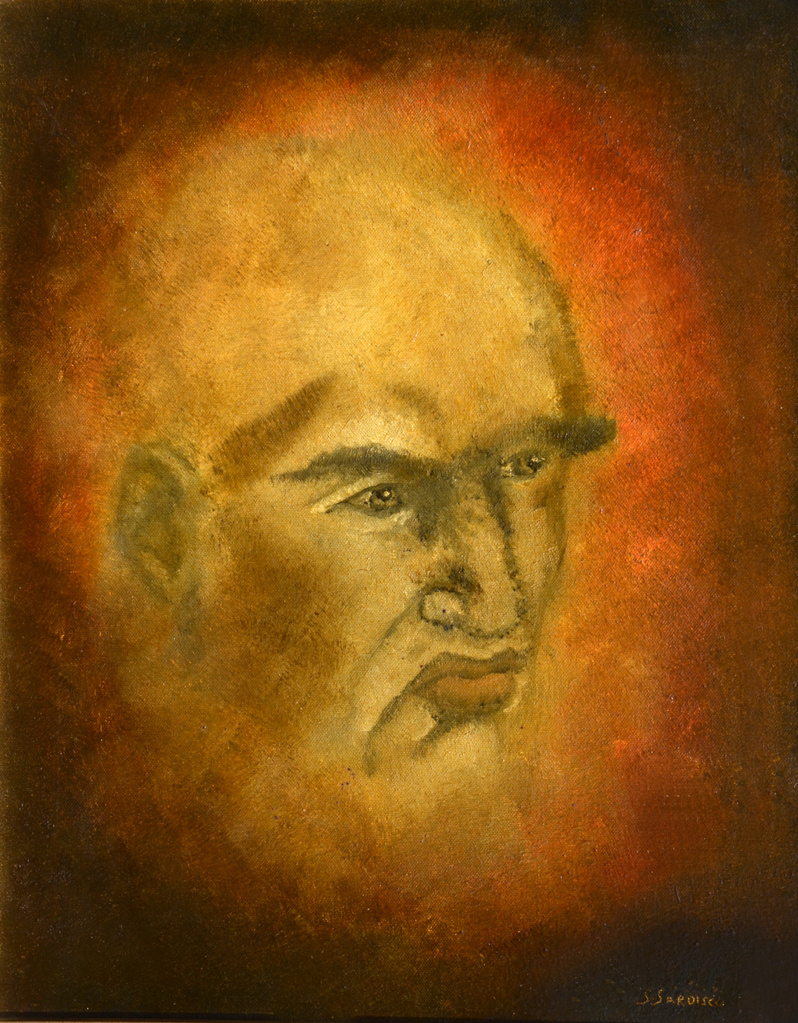 Il Saggio
Il Saggio
1972, 30 x 40 olio su tela
LL Sapienza si accompagna al desiderio, allo sforzo medesimo di vedere, capire e comprendere. Ancora una volta lo “sguardo” è assoluta purezza espressiva.
The knowledge is with the desire, with the effort to see, to understand and to comprehend. The look at the reality is an absolute expressive purity, once again.
04
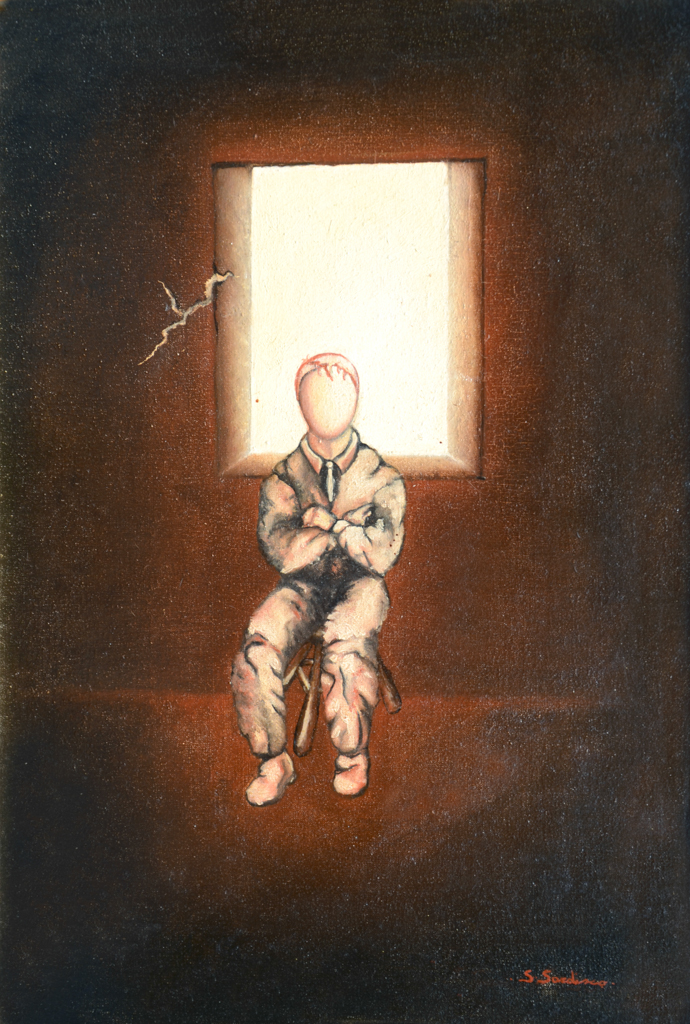 Ragazzo recluso
Ragazzo recluso
1972, 35 x 50 olio su tela
Opera di grande valore biografico oltre che artistico.
Salvatore a tredici anni ha già una matura arte pittorica che si intreccia ad evidenti rimandi della sua vita, ai cinque anni trascorsi in collegio.
Ne esce significativamente e simbolicamente rappresentata la sua infanzia chiusa tragicamente verso l’esterno: la crepa, raffigurata in profondità, rimanda chiaramente alla rottura fra la società ed il ragazzo recluso, alla ricerca della propria identità.
Si dispiega così il romanzo del piccolo di StYluS, colto in un attimo intenso e ricco di intima significanza: la sofferenza, la tristezza, la solitudine, l’isolamento che è alla fine ribellione costante e decisa verso qualsiasi forma di reclusione materiale, spirituale e culturale.
A great biographical and artistic painting.
At the age of thirteen, Salvatore has just a mature pictorial art that interweaves with evident connection of his life during boarding schools’s years. He goes out from there symbolically represented in this example of childhood closed toward the outside world. The crack, represented in depth, connects clearly to the breakup among the society and the recluded boy searching his identity.
So, this is the romance of StyluS’s childhood, focusing on the intense instant full of a deep reason, tragically represented by suffering, sadness, loneliness, solitude that is – at the end – constant and firm rebellion toward all form of material, spiritual and cultural imprisonment.

